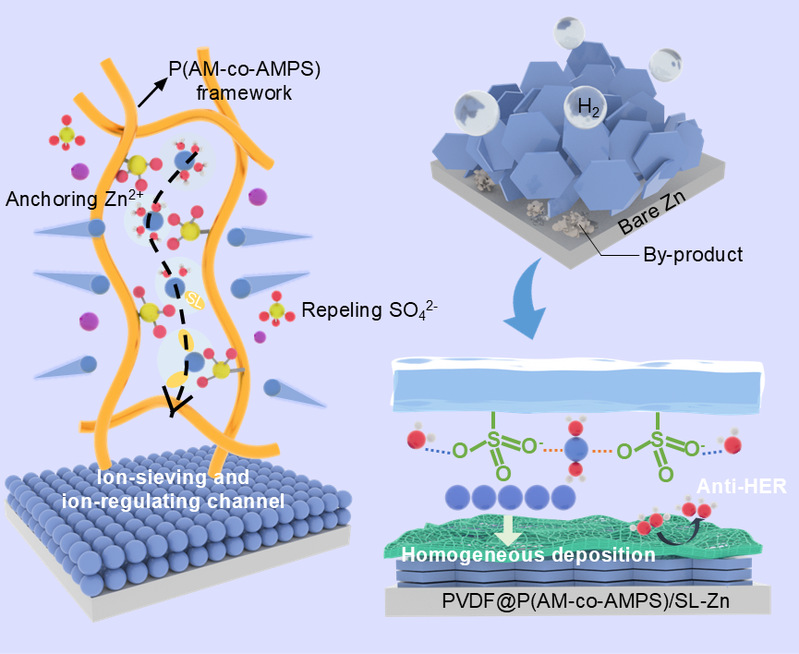Recently, a research paper titled Lignin-Derived Polyanionic Cross-linked Gel Interfacial Layer with Ion-Sieving and Ion-Regulating Capabilities for Dendrite-Free Zinc Anodes by the team of Professor Shimou Chen from the College of Materials Science and Engineering was published in Angewandte Chemie International Edition. This study innovatively designed a multifunctional interfacial protective layer for Zn anodes, composed of polyvinylidene fluoride (PVDF) and a polyanionic gel, achieving stable long-term cycling in zinc-ion batteries.

The three main challenges facing Zn anodes are ion flux regulation, interfacial stability, and crystal orientation control. This study proposes a novel protective strategy for Zn anodes that combines dynamically adaptive protective properties, ion-sieving, and ion-regulating capabilities. Specifically, a hydrophobic PVDF layer was formed on the Zn electrode via the doctor-blading technique, followed by the in-situ photopolymerization construction of a polyanionic hydrogel layer (P(AM-co-AMPS)/SL). Together, they form the PCOPSL-Zn protective layer. P(AM-co-AMPS)/SL comprises two active components: the P(AM-co-AMPS) copolymer and sodium lignosulfonate (SL) molecules. The introduction of SL not only enhances the structural stability and cycling durability of the interfacial layer but also forms an adaptive molecular adsorption layer on the Zn electrode surface to homogenize the interfacial electric field.
The free and semi-immobilized polar functional groups within P(AM-co-AMPS)/SL collectively endow the interfacial layer with ion-sieving and ion-regulating effects: The well-designed P(AM-co-AMPS)/SL exhibits significant electrostatic repulsion capability, creating a chemical microenvironment that inhibits SO₄²⁻ migration, effectively hindering the formation of zinc hydroxysulfate byproducts. This structure enhances the selective adsorption of Zn²⁺ through the synergistic action of electrostatic attraction and coordination mechanisms. The hydrophobic PVDF barrier layer synergizes with hydrogen bonding in P(AM-co-AMPS)/SL to reduce the content of interfacial active water, thereby minimizing side reactions at the Zn interface.
The results demonstrate that the PCOPSL-Zn||Cu asymmetric cell achieves over 2300 stable cycles at 5 mA cm⁻² with a high average Coulombic Efficiency (CE) of 99.96%. The PCOPSL-Zn||NaV₃O₈·1.5H₂O full cell retains a capacity of 176.1 mAh g⁻¹ after 1000 cycles at 5 A g⁻¹, and 101.2 mAh g⁻¹ after 2500 cycles at 10 A g⁻¹. This work provides a new approach for developing high-performance aqueous zinc-ion batteries.
The first author of this work is Wanting Zhou, a Master student at the College of Materials Science and Engineering, Beijing University of Chemical Technology. Professor Shimou Chen from Beijing University of Chemical Technology is the corresponding author. This work was supported by the National Natural Science Foundation of China, the Fundamental Research Funds for the Central Universities, and other projects.
Paper Link:
https://onlinelibrary.wiley.com/doi/10.1002/anie.202508359


